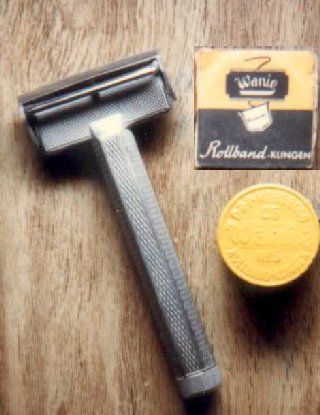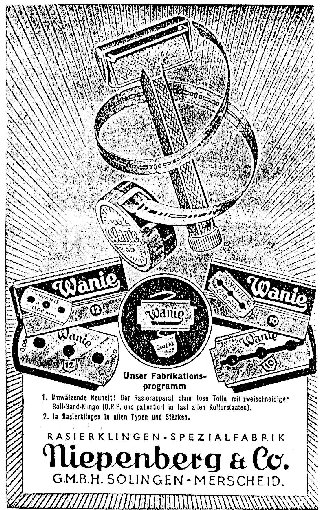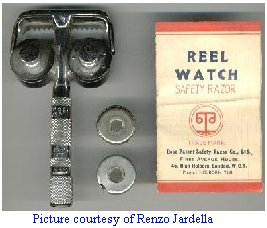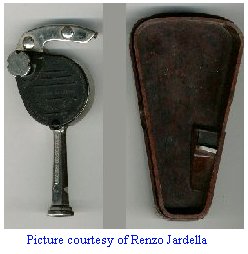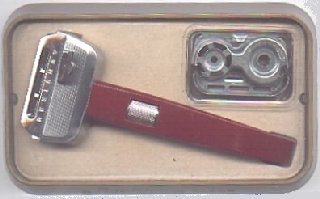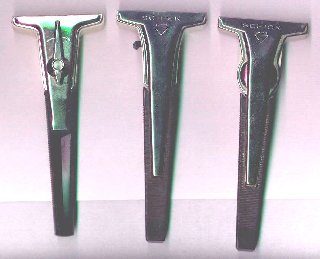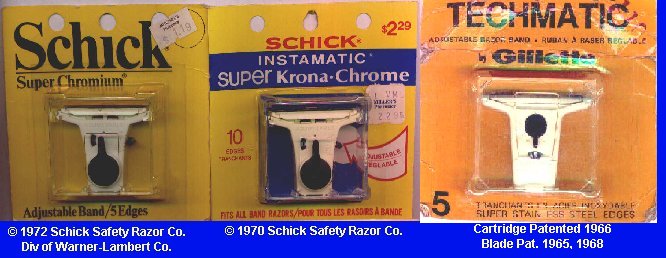|
Wanie, Reel Watch, Razor Six, Reelshav, Techmatic, Auto-Band, Flicker |
Band razors do not play music! But curiously, their band blades are often housed in cartridges that resemble music tape cassettes. They are characterized by a blade which is a continuous "band" of sharpened steel that is wound through the shaving head to bring a new edge into play and store the old, dull one. Band razors saw their brief commercial heyday in the 1960's and by the mid 1970's all but one, the ASR Flicker, had given way to the new technology of the Trac II double blade cartridge. In many ways, form as well as function, the band razor seemed to both capture the spirit of an age, and create a new way of thinking about razors and blades.
THE RAZORS
When Gillette unveiled their Techmatic Band Razor in 1965, it seemed to many like a revolutionary new technology. In fact, patents for similar ideas had been issued many years before, and at least four commercial band blade razors preceded the Techmatic.
The earliest use of the "band blade" technology appears to be the Wanie, manufactured by Niepenberg & Co. of Solingen Germany, apparently in the 1930's. Wanie seems to have been a blade business producing both three-hole and slotted double edge blades to fit Gillette type razors.
The significance of the Wanie "Rollband" was that the blades were similar to regular blades, connected in a long strip that was contained in a little pill box shaped dispenser, presumably one of the first models of blade dispenser. Apparently the blades were rolled out into the shaving head and snapped off the strip as required, and the blade dispenser was not an integral part of the razor as in later versions of the Band Razor. The history of the Wanie is not well known.
The Reel Watch Razor was British, made in the early 1930's by the Rose Patent Safety Razor Co. Ltd. of London. Information from a former employee suggests the razors may have been made by Darwins Ltd., of Sheffield, who made their own unique razor. The thin band blade was wound across the shaving head, with comb guard, from one reel container to another, with the old containers sent back to the factory for refills. The Reel Watch razor came in a bakelite box for 21 Shillings or a metal box for 30 shillings, with a spare blade container costing 5 shillings and sixpence with a one shilling deposit for return. The Reel Watch did not appear to be a commercial success, and very few examples are known, in fact the story from the former employee suggests a manufacturing defect lead to most of the razors being recalled and destroyed. Most of the information and the picture are courtesy of collector Renzo Jardella of London, England.
The Razor Six was made in France in about 1936. This unusual razor came in three variations all quite similar, according to collector Renzo Jardella of London, England, who supplied the information and picture. The Razor Six has a length of blade similar to 8mm film with holes all along one side that locate into the teeth on the wheel, which is turned to move a new piece of blade into the shaving area, with the old bit of blade then snapped off using the metal lever attached to the inside of the lid.
The Warner-Hudnut "Reelshav" from 1964 was a significant band razor that presaged but did not share the commercial success of this genre. This razor, pictured at the right, had a blade cartridge very much in the style of a common reel-to-reel tape cassette, and the blade band was wound across the head from one reel to another. It was like an elegant modern version of the Reel Watch Razor featured above. The Reelshav was not a commercial success, only lasting in the market place for a year or two, but is now much in demand as a collectible. When the Gillette Techmatic entered the market place in 1965, it galvanized its major competitor, the Schick Safety Razor Co., to produce a similar line of product. So 1966 saw the introduction of the Schick "Auto-Band" razor, which was very similar to the Gillette Techmatic. The two razors are shown here side by side for comparison. They are very similar in appearance.
Above Left : (from left to right)
Gillette Techmatic and Schick Auto-Band Razors
The front view shows the original Gillette cartridge without blade angle adjustment, plus the original Schick cartridge (on right) and the later Schick cartridge. See other cartridge designs below. Above Right: (from left to right)
Gillette Techmatic and Schick Auto-Band Razors
The back view shows the Gillette winder and the early pre-1970 (on right) and later Schick. Left: Gillette cartridge opened to show how the band blade is wound across the shaving head.In an interesting move in 1968, Gillette introduced their "Orbiter 4000" band razor. This electric version of the Techmatic apparently vibrated at 4000 cycles per second, much as earlier vibrators like the Tark and Vibro-Shave, and more recent incarnations like the Remington Trac II type battery powered vibrators.
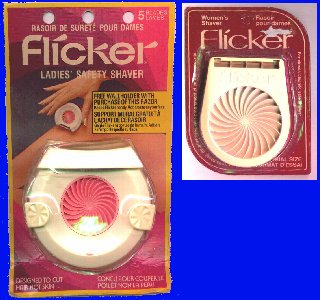
Later, in 1971, American Safety Razor entered the band razor field with their "Flicker" razor for women. It was a one-piece unit that was in effect, the first disposible razor designed exclusively for women. It had a central wheel mechanism that moved the blade edge along. It also had a wire wrapped blade, the first successfully marketed. The Flicker went on to a long life of success. By the middle 1970's, it was the number one ladies razor on the market, and I have bought examples off pharmacy shelves within the past five years.
THE BLADES
The main difference between the Schick Auto-Band and the Gillette Techmatic was in the blade cartridge. The Techmatic had a winder mechanism built into the razor with a cog that seated itself in the blade cartridge, while the Auto-Band had the winder built into the blade cartridge itself. Both cartridges also eventually incorporated controls to vary the angle of the blade from low to high for a custom shave, although the original Gillette cartridge did not have this feature. The Schick blade angle lever is on the side of the cartridge, while the Gillette lever is on the front where the Schick winding lever is. The real trick was that the Schick cartridge would fit into a Gillette Techmatic, but the Techmatic cartridge would not fit into the Schick Auto-Band because it could not be wound on.
THE PRODUCT
None of these improvements made band razors either big selling or long lived products. According to Phillip Krumholz's "Gillette Collector's Handbook", in 1967 (at the time of the ad on the right) band razors comprised one-third of all new razor sales, but half these new users switched back to their old blade system within a short time. By the early 1970's band razors saw themselves losing ground, with the introduction of the twin bladed TRAC II in 1971 likely sounding the final death knell.
Band razors seemed to have captured both the spirit of the age in which they were invented , and to have introduced new ways of thinking about shaving technology. The spirit of the age is in the technology of the band blade cartridges. It's a total break from the razor and blade combinations of the past, just as in many ways the 1960's were a break from other things in the past.
If you look at the Warner-Hudnut Reelshav, you see the form of a common tape cassette, which at the same time was beginning to make inroads into the long reign of vinyl in the world of sound. The Schick and Gillette cartridges, and the whole Flicker razor resemble an 8-track cassette, once the rival of reel-to-reel cassettes. And in terms of shaving technology, the cartridge system, as a holder for a blade mechanism, previews the Trac II type twin blade cartridge which in the end, spelled the doom of the band razor, and ultimately the common blade type razors of the past.
COLLECTOR NOTES
As collectibles, oddities like the Reel Watch and Razor Six are very rare, with few examples known. A Reel Watch sold on EBay on January 19, 2003 for $461.78 USD. The Wanie is also rare and very collectible, followed by the Gillette Orbiter 4000 and the Warner-Hudnut Reeshav. The Schick Auto-Band is scarcer than the Gillette Techmatic, although in truth neither are highly sought after like their older cousins. Maybe in time their day will come again, as collectibles from an interesting part of a dynamic decade when shaving systems went through major innovation and changes that lead to the standard cartridge-blade systems in use today.
Copyright: This web page, its design and content, are copyright Alan G. Appleby 2000-2003, all rights reserved, unless otherwise credited. Credits:Some of the information on this page was adapted from "The Complete Gillette Collector's Handbook" by Phillip L. Krumholz (1992). The Wanie information and other technical details are courtesy of Robert K. Waits, or are from his "Safety Razor Reference Guide" (1992). Information and pictures of the Reel Watch and the Razor Six were provided by Renzo Jardella of London, England, one of the world's premier safety razor collectors.
